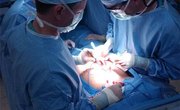A cardiothoracic surgeon is a specialist with surgical expertise of managing disorders of the lungs, esophagus, heart and all the main blood vessels located in the thoracic cavity, according to The Society of Thoracic Surgeons, which also asserts that lung cancer and cardiovascular diseases are the top two killers in U.S. Cardiothoracic surgeons play a critical role in enhancing the life expectancy of many patients. Half of the 3,500 cardiothoracic surgeons currently working in the U.S. will retire in the next decade, according to The Society of Thoracic Surgeons. The field requires new specialists to fill this gap and cater for the medical needs of the population.
Undergraduate
Getting a bachelor’s degree is the first step toward becoming a cardiothoracic surgeon. In undergraduate school, you can major in any field as long as you take courses required for admission to a medical school, such as one year of calculus, organic chemistry, physics, general biology and chemistry. The Medical College Admission Test is a requirement for most medical schools. You apply to take this standardized multiple-choice test that covers verbal reasoning and physical and biological sciences during your junior year in college. To get ready for the exam, take an MCAT preparatory course available online or in universities months before the final test.
Medical Degree
You must obtain a medical degree that usually takes four years to complete. For the first two years, a medical student spends time in the classroom studying clinical medicine and basic sciences. Coursework covers all clinical disciplines, such as immunology, endocrine, nervous, pulmonary and cardiovascular systems as well as biochemistry. During the third year and fourth year, you gain clinical exposure through undertaking rotations in healthcare facilities under the supervision of qualified physicians. You work in all areas, such as internal and family medicine, neurology, surgery and pediatrics during these rotations. You apply for general surgery residency during your final year in medical school.
Residency Training
Residency training in general surgery usually takes five years with rotations in different fields of surgery, such as oncology, pediatric, urology, orthopedic and gastrointestinal. You get exposure to cardiothoracic surgery during rotations in your first to third year of the residency training program. Most training programs require students to gain additional experience through undertaking a one- or two-year research venture. You apply for cardiothoracic residency training in your fourth year, which takes two or three years. You learn to carry out clinical trials, heart-valve, esophageal and lung surgery during this residency. After completing this second training, you can sit for the American Board of Thoracic Surgery exam. Passing this exam is the last step in becoming a cardiothoracic surgeon. You can gain additional experience by pursuing fellowship opportunities in heart transplantation, lung disorders and children’s heart surgery among others.
Licensing
Cardiothoracic surgeons need a license to practice in any state in U.S., just like other doctors. Although licensure varies across most states, you must pass a licensing exam that aims at evaluating your capability to treat and identify surgical problems. Upon passing the exam, you can start practicing as a cardiothoracic surgeon and remember to renew your license after expiry. Renewal may require additional training and education.
Related Articles
References
Writer Bio
Maria OCadiz has been writing professionally since 1982, most recently publishing for various websites on topics like health and wellness, and education. She holds a Master of Arts in Education. She is a former university professor, curriculum facilitator and teacher.











